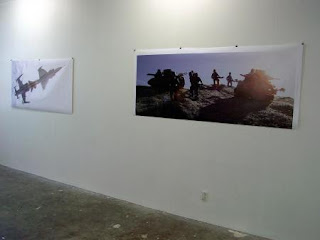
Trevelyan’s show was a timely examination of media culture and war. Exhibiting digital images alongside real time scupture relayed by close circuit tv, Trevelyan presented the public with his own version of “press” machinary. Complete with exageratted lens flare, Trevelyan’s show was overtly political. Alongside the digital images was a “doctored” press that alluded to the manner in which information can be manipulated to political gain.
PACKAGE REVIEW: An easy way into this show is the Photoshop flare it so readily deploys. It's quite easy to write it off as a gimmick, an "in-house" currency that renders the images, worthwhile, even smart, and somewhat savvy. But this kind of cognoscenti smugness is as shabby as the rhetoric that George Bush jnr invites us to indulge in as we pursue that ubiquitous terrorist. So if we dodge all this, if we tackle this propaganda genuinely, we begin to understand more about the languages of war, and even more about the facades power uses to deploy war with. One such facade is the "doctored" Press that reveals that very "language of war" that lurks behind it's journalistic "objectivity". Trevelyan serves a deft slap to Canterbury's "fresh each day" as careful "censors" and overwrites reveal a circulation of "warmonger" talk; predators / tanks / missing / removed ... what was once common daily language is now geared by the approaching escalation of "middle-eastern" "conflict". (so many inversion's - so many loadeds - why can't we just shoot, just plain talk - like a Texan would?Trevelyan's pictures are taken from models, he's been role-playing the guises of war - his troops partake in the practice of war. The lens flares portend satellite communications, bubble-domes, or chains of command / or better still, the child, the miscreant's magnifying glass, as though our law "enforcer' is attempting to destroy the game before it’s begun. This then forces us to ask questions about how war begins, about how war is controlled, but more importantly, about the ways in which we “think” through soldiers, the ways in which we use “attack” as deterrence.





